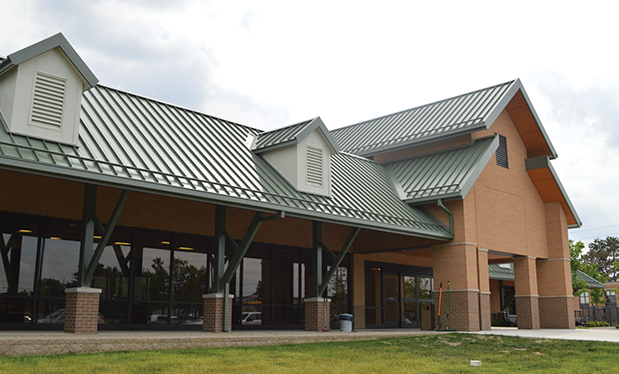July 30 in Ellicott City, Md., began as a typical hot summer day. Founded in 1772 as a mill town along the bottom of a deep valley through which the Patapsco River flows, the city had seen plenty of serious floods. But July 30 proved to be anything but typical. That day, what the National Weather Service has called an "off-the-charts" thousand-year rainfall event (in terms of recurrence interval) occurred, creating chaos and destruction as flash floods ran through the middle of the city after more than 6 inches of rain fell in two hours. With little warning, Main Street became a turbulent river tossing cars, smashing storefronts, gutting small shops and leaving devastation, lost lives and massive sinkholes in its wake.
Adapting to a changing climate
News reports during the past year have detailed major weather disasters nearly every month, making what used to be once-in-a-lifetime events appear almost commonplace, and communities throughout the U.S. are facing increased drought or more intense storms.
Shorter, warmer winters have led to decreased snowpack and rapid spring melting, accelerating erosion and drying of grassland well before summer heat arrives. Weather-related emergencies such as rising sea levels, heatwaves, floods, hurricanes, windstorms, water surges, land subsidence and forest fires are increasing in frequency and severity. The result has been construction, electrical supply and transportation challenges unseen in our lifetimes.
Disasters are expensive in human and property costs, but much of the destruction can be prevented with cost-effective mitigation features and advanced planning. A 2005 study funded by the Federal Emergency Management Agency (FEMA) and conducted by the National Institute of Building Sciences' Multihazard Mitigation Council found every dollar spent on mitigation would save $4 in losses. Improved building code requirements during the past decade have been the unifying force in driving high-performing and more resilient building envelopes, especially in states that have taken the initiative to extend these requirements to existing buildings. Adapting to changing conditions requires unprecedented investment by individuals and government entities, but failing to adapt would be even costlier—not only for the next disaster but also for the many events to follow.
The urgency of these changes necessitates radical change in the way we approach construction materials, methods and risk management. We cannot base requirements on historical weather patterns because the past no longer is a reliable map for future hazards. On community-wide and building-specific levels, we must create and implement plans to address robust weather, climatic events and national security threats through changing codes and standards to improve the capacity of our built environment to withstand, absorb and recover from stress. In short, we need to build resilience.
Resilient construction
According to the Resilient Design Institute: "Resilience is the capacity to adapt to changing conditions and to maintain or regain functionality in the face of stress or disturbance."
Resilient construction makes buildings more adaptable to extreme climatic, natural disasters, cyber or other related disruptive events. Resilient construction ensures a structure will be more resistant to damage caused by hazards that destroy buildings or interfere with their performance. According to the Urban Land Institute: "'Resiliency thinking' requires us to think not only about bouncing back from environmental, economic and social crises, but adapting to changing circumstances by 'bouncing forward' through new paradigms, processes and ways of working."
Resilience is more than durability; it encompasses maintaining functionality of critical systems despite adverse conditions. Hospitals, fire and police stations, and other critical facilities can't merely endure a trauma, they also need to continue to serve their designated functions during and after disruptive events to enable first responders to monitor conditions and lead recovery efforts. Engineering and retrofitting these buildings to the highest standards of resiliency can save lives in emergency situations.
When facing these challenges, designers, manufacturers and contractors can build upon current practices. For many years, the construction community has placed value on sustainable design—reducing environmental impacts by improving building materials and performance. Resilient design embraces these goals but repurposes them: A building that employs passive strategies to use less energy also will be better able to remain operational during and after a weather disaster. Highly energy-efficient buildings require less backup capacity than traditionally designed buildings, so redundancy always will be more affordable when a building has incorporated sustainable practices. Promoting the construction of energy-efficient buildings and infrastructure by using durable, long-lasting materials ultimately is more cost-effective because structures that withstand disruptive events will not require costly reconstruction.
Few systems in buildings play a more critical role in the ability to perform well in disasters than roofs—they resist the elements; maintain the safety of occupants; and can serve as platforms for lighting, water and power equipment. As FEMA and state agencies have formulated recommendations to protect existing electrical sources for a structure, increasing roof capacity to serve as a flood-protected platform has become a major target for designers.
In addition to increasing the surface durability and resistance to facilitate these changes, the roofing industry has to review its installation procedures with an eye to redundant detailing or other improvements. For example, what are the characteristics of fully adhered roofs versus mechanically fastened roofs that create greater or lesser building resilience? What materials optimize the likelihood of resilient performance given a roof's location?
These performance-enhancing changes can provide opportunities for industry growth and adaptation. Potential energy disruptions demand high-performance insulation and windows to maintain a habitable environment in the critical early hours and days after a climate event. Research is ongoing to find roof systems rigorous enough to withstand hail, increased snow loads, ultraviolet radiation, temperature fluctuations and wind uplift while accommodating more equipment. New techniques to improve the installation quality and performance of these technologies will require more training for contractors and engagement by manufacturers regarding the installation of their products to optimize performance and value.
The time is now
This cooperation won't happen without a dedicated effort by all the major sectors of the construction industry, especially those responsible for roof systems. A recently formed coalition composed of roofing manufacturers, trade associations, and representatives from FM Global and FM Approvals is a great example of how the industry has come together to collaborate on solutions to complex roofing-related issues.
When discussing resilience issues, Reed Hitchcock, executive vice president of the Asphalt Roofing Manufacturers Association, oversees the coalition's efforts and observes: "A logical next step would be for our industry to do an even better job collectively getting in front of those issues and work with other stakeholders."
It also is commendable that since 1990, the Roofing Industry Committee on Weather Issues (RICOWI) has investigated roof system performance following weather events. Including contractors, academics, designers and manufacturers, RICOWI is a great starting point for the cooperation necessary to face the task ahead.
It is essential for RICOWI, with the assistance of NRCA, RCI Inc., Construction Specifications Institute and The American Institute of Architects, to expand its reach and convene a summit to create an industry blueprint for "resilient roofing." The summit could address materials and installation and maintenance processes necessary to achieve optimum performance for every product's attribute. Industry trade shows, conferences and online course work need to not only focus on what have been historic weather patterns and hazards but also assess the effects of new uses for roofs that enhance the overall ability of buildings to "bounce back" and challenge roof durability in a manner not usually anticipated.
In addition, the entire building envelope industry, together with government and academia, should make continuing efforts to learn from the wind-related disaster performance of existing building systems. For example, the National Windstorm Impact Reduction Program was developed by Congress to heighten the government's "understanding of windstorms and their impacts" and includes a wide array of government and standard-setting bodies. The National Institute of Science and Technology (NIST), the hosting organization for the effort, believes a strategic plan will be ready for public comment in the spring of 2017.
Gaining traction
Public policy on overall community resilience is attracting attention at all levels of government and the private sector. Recent summits sponsored by the White House and national policy think tanks reflect the growing realization this problem requires an integrated solution. Standard setting by organizations such as the Insurance Institute for Business & Home Safety (IBHS) with its FORTIFIED Home™ program and related work by NIST, FEMA, and the Department of Housing and Urban Development (HUD) are starting to show progress with improved and hardened design recommendations.
FORTIFIED Home is a set of engineering and building standards designed to help strengthen new and existing homes through system-specific building upgrades to minimum building code requirements that will reduce damage from specific natural hazards. The FORTIFIED Home program has three levels of designation—Bronze, Silver and Gold—that build upon each other, allowing homeowners to select the desired level of protection that best suits their budgets and resilience goals.
NIST's Community Resilience Program, part of NIST's broader disaster resilience work, is a multifaceted program that assists communities and stakeholders with issues related to buildings and the interdependencies of physical infrastructure systems. The program has developed The NIST Community Resilience Planning Guide for Buildings and Infrastructure Systems, which provides a flexible approach to help communities improve their resilience by setting priorities and allocating resources to manage risks for their prevailing hazards.
Leaders representing multiple federal agencies have expressed interest in common indicators of community resilience to help inform and prioritize resilience policy, capacity-building strategies and outcomes. FEMA and the National Oceanic and Atmospheric Administration initially undertook a joint project to explore resilience indicators and measures. The project then evolved into a broader interagency partnership under the Mitigation Framework Leadership Group.
And HUD's Office of Economic Resilience (OER) helps communities and regions build diverse, prosperous and resilient economies. OER manages a cross-cutting portfolio of work broadly organized in three primary topic areas: resilience, place-based, and energy efficiency and green building.
Even companies such as Qualcomm and Philips Lighting are assessing how their products can extend resilience of connectivity and lighting in buildings. For example, Walmart has retained a full-time meteorologist to help it predict where climate disasters are likely to occur so stores can respond and prepare more quickly.
Time for action
Rather than trying to do the minimum possible to meet requirements, building practitioners need to think beyond codes to design structures built not only to withstand but also to thrive in extreme circumstances. Leveraging these ideas to support resiliency across the construction industry will accelerate the pace of change and position participating groups well to build for the future.
Confronted with growing exposure to disruptive events, the building industry has an opportunity to work cooperatively to meet the challenge of designing solutions that provide superior performance in changing circumstances to reduce long-term costs and limit disruptions. Achieving such integration requires active collaboration among building team members to improve the design process and incorporate new materials and technologies, resulting in high-performing structures that are durable, cost- and resource-efficient, and resilient.
Jared O. Blum is president of the Polyisocyanurate Insulation Manufacturers Association.



